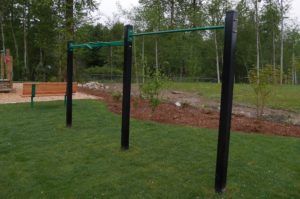The Pull-up and the Chin-up, such words evoke fear into the hearts of many. One imagines hard strenuous labor; three feet is a long journey to make and each painful second hurts more than the last. This is all true, by the way, which is why they are invaluable to your workout. One of our best fitness stations for lats is the Pull-Up / Chin-Up Bar.
If you’re a person who prefers downs instead of ups (as in sit down, lay down, and chow down), then this blog is for you. Not only will we explain the importance of these two exercises, but we will also show you the proper way to perform them, and pretty soon you’ll be busting out reps left and right!
Latissimus Dorsi (Lats)

The lats muscle originates on the lower half of your back, along your spine and hip, and attaches to the inside of your upper arm. The primary job of two lats is to pull your upper arms from a raised position down to the sides of your torso, as when you grab an object off of a high shelf. That’s why exercises that require this movement, such as chin-ups and pull-ups are popular back builders. They work the lats, teres major muscle, and biceps. What’s more, your core, middle and upper back muscles are involved, assisting in the movement or acting as stabilizers in most versions of this exercise.
Pull-ups
- Grab the bar with a shoulder width overhand grip
- Hang at arm’s length. You should return to this position – known as a dead hang – each time you lower your body back down.
Chin- ups
- Grab the bar with a shoulder width underhand grip
- Hang at arm’s length. You should return to this position – known as a dead hang – each time you lower your body back down.
Do you see the similarity? The only difference in the pull up bar exercises (pull-up vs. chin-up) is the hand position; however, even this slight difference means you’ll be working different muscles. It is important to do this exercise both ways. Each tiny muscle has a purpose and often one works with the other.
Perhaps a better name for the chin-up and pull-up would be the “chest up”. That’s because to attain the most benefit from this exercise, you should actually pull your chest to the bar. This increases the range of motion for the exercise and engages more of the muscles that surround your shoulder blades.
That’s all it takes to do a good old-fashioned pull-up bar exercise. It is difficult at first, but once your body becomes used to the routine, you’ll be challenging yourself to reach new heights. As your arms and back strengthen, it might surprise you how some of those simple everyday tasks get a little bit easier.
For more information about installing a fitness system for pull-up bar exercises, please contact us at Pacific Outdoor Products Inc.



